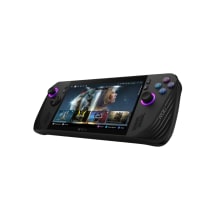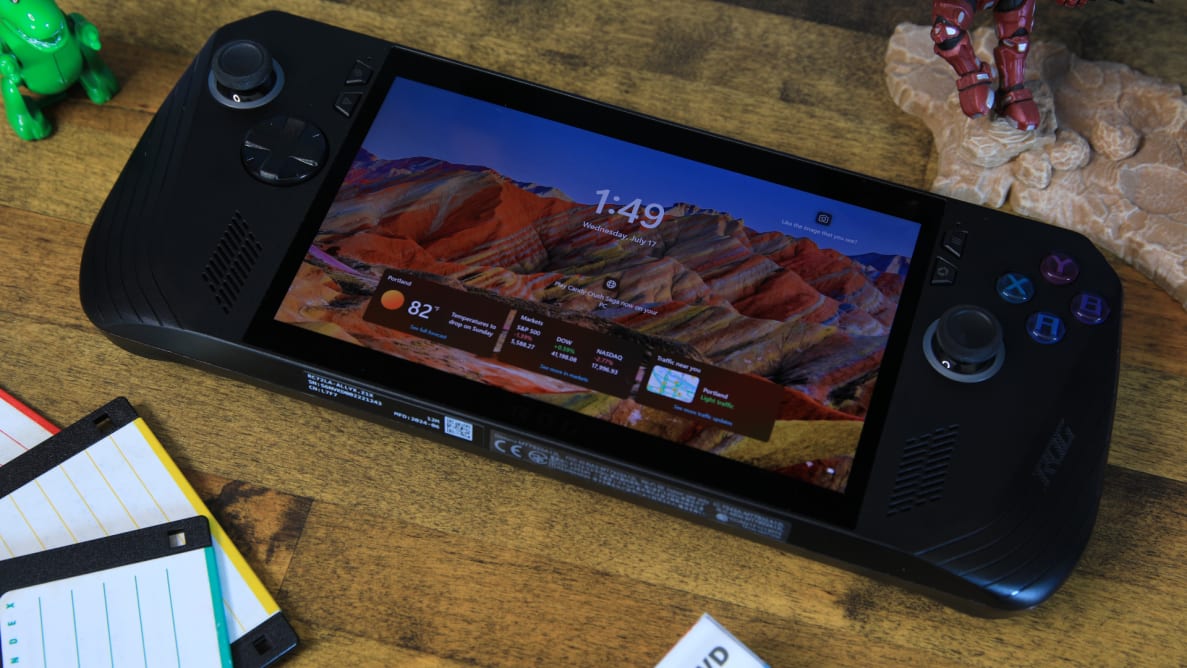Pros
-
Comfortable to use
-
Attractive design
-
Excellent display and speakers
Cons
-
Disappointing performance
-
Quirky software
-
Quality issues
About the Asus ROG Ally X
The Asus ROG Ally X uses the familiar AMD Ryzen Z1 Extreme processor found in other handhelds including the older ROG Ally Z1 Extreme and the Lenovo Legion Go. However, it does receive an upgrade from 16GB to 24GB of memory, and the memory’s speed is increased from 6400MHz to 7500MHz.
That’s not all. The Ally X also doubles the size of the battery over the Ally Z1 Extreme from 40 to 80 watt-hours. The solid-state storage is doubled, too, from 512GB to 1TB. The theme continues with USB-C; the Ally X has two USB-C ports, while its predecessor had just one.
These upgrades bump the price from $700 to $800 MSRP. In practice, though, the Ally X is about $250 more than the Ally Z1 Extreme, which is routinely discounted to $550. That’s a pretty steep increase, though one that ultimately feels justified.
Asus ROG Ally X specs:

The Asus ROG Ally X uses slight redesigns all over, like textured triggers.
- Price: $800
- Processor: AMD Ryzen Z1 Extreme (8 cores, 16 threads, 5.1GHz Boost Clock)
- Graphics: AMD Radeon Graphics, 12 compute units up to 2.7GHz
- Memory: 24GB LPPDR5X 7500MHz
- Storage: 1TB PCIe 4.0 M.2 2280 NVMe drive
- Display: 7-inch 1,920 x 1,080, 120Hz IPS touchscreen
- Ports: 1x USB-C 4 / Thunderbolt 4 with DisplayPort Alternate Mode and Power Delivery, 1x USB-C 3.2 Gen 2 with DisplayPort Alternate Mode and Power Delivery, 1x microSD card reader, 1x 3.5mm combo audio jack
- Connectivity: Wi-Fi 6E, Bluetooth 5.2
- Battery: 80 watt-hour capacity
- Weight: 1.49 pounds (678 grams)
- Dimensions: 11.02 x 4.37 x 1.45 inches
- Special features: Customizable RGB-LED thumbstick lighting, fingerprint reader in power button, 2x software customizable rear paddle buttons
- Warranty: 12-month manufacturer warranty
What we like

The back of the Ally X has been redesigned for deeper grips and paddle buttons that are harder to hit by accident.
It looks great and feels solid
The original Asus ROG Ally Z1 and Ally Z1 Extreme looked excellent but had some problems. The Ally Z1 had spotty Wi-Fi and the tension spring for the left shoulder button sprung free during our review. Some Ally owners also had an issue with it frying microSD cards, which caused Asus to extend the original Ally’s warranty from 12 to 24 months and promise reimbursement for damaged microSD cards.
However, our experience with the ROG Ally X was far better than with either first-generation Ally. The new model looks and feels more solid and doesn't have the hardware issues and software bugs we experienced before. On the contrary, we saw zero such issues during testing (that could be blamed on the handheld, at least).
Asus upgraded the Ally X with numerous quality-of-life enhancements, none of which are huge on their own but collectively make a difference. The corners are rounder; the D-pad is slightly larger; there’s an extra USB-C port; the fan vents are larger; the triggers and shoulder buttons are larger; the bonus programmable buttons on the bottom of the handheld are smaller and have been relocated, and the device is now black instead of white.
The Ally X’s design still isn’t perfect. It’s a bit thicker than before, the volume buttons remain hard to reach, and there’s still no touchpad for easy cursor input in Windows. Taken as a whole, though, Asus’s tweaks are an improvement. The Ally X is comfortable to hold, the buttons are easy to access, and the extra USB-C port is a big deal if you plan to use the device with a dock, monitor, or television.
When compared to a Lenovo Legion Go or Ayaneo Air, the Ally X takes a win in comfort. It even rivals the Steam Deck OLED, though the Deck’s inclusion of touchpads and greater width can be better or worse depending on the games you want to play.
The big battery is a win for portability
While the Asus ROG Ally X has some performance enhancements, the battery is the headline hardware upgrade. The Ally X doubles the capacity of the battery in the original Ally.
That implies battery life has doubled, and our testing showed that is more-or-less correct. While the original Ally often drains the battery in about two hours or less when the power profile is set to the 17-watt Performance mode, the Ally X can handle about four hours. If you stick to less demanding games and use the lower-performance Silent mode, battery life can exceed five hours.
It’s a difference that fundamentally alters how the handheld is used. The Ally’s battery was ok for most handheld gaming sessions, which tend to be shorter than playing at a desktop or on the couch, but we had to make sure to charge it at the end of each session or the Ally would have nothing in the tank the next time we picked it up. With the Ally X, we often ended a gaming session with more than 60 percent of the battery left, so constant charging wasn’t required.
The Ally X also outlasts most of the competition, most of the time. The specifics do vary: you might be able to squeeze more life from a Steam Deck OLED, which has a 50-watt-hour battery, in less-demanding games (up to 8 hours in some cases). In general, though, the Ally X has an edge in portability.
Performance is excellent (for a handheld)

It's powerful enough to run big modern titles.
The Asus ROG Ally X retains the same AMD Ryzen Z1 Extreme processor as before but receives an upgrade to its memory. The amount of memory has increased from 16GB to 24GB and its speed has increased from 6400MHz to 7500MHz. This doesn’t wildly improve the experience, but it’s more relevant to a handheld PC because the Z1 Extreme’s integrated graphics doesn’t have dedicated memory and instead rely on system memory.
The Ally X achieved a 3DMark Time Spy score of 2,729 in the 17-watt Performance mode when plugged in, and dipped to 2,661 on battery power. The 30-watt Turbo (which is capped at 25 watts when on battery power) increased that to 3,488 and 3,269 when plugged in and on battery, respectively. These scores are slightly better than the Ally Z1 Extreme, which scored 2,400 in its Performance mode on battery power, and similar to the Lenovo Legion Go, which scored 2,809 in its Performance mode on battery power.
We spent much of our testing time playing the Dawntrail expansion for the MMORPG Final Fantasy XIV, which recently received a graphics update. The Ally X handled the improved visuals well. In Performance mode on battery power, it averaged 36 frames per second (fps) in the game’s benchmark at 1080p resolution and the Standard (Laptop) preset. The Turbo mode barely beat that with an average of 37 frames per second, again on battery power.
Real-world performance was better than the benchmark, with a typical average of 40 to 50 fps in Performance mode, with dips closer to 30 fps in cities packed with players. Keep in mind that all of these figures were achieved without dynamic resolution scaling enabled. When that feature is on, a more-or-less steady 60 fps is possible.
Other less demanding games also achieved good results at 1080p and lower detail settings. Valheim, a game the Steam Deck tends to struggle with, was playable at 1080p and its Low preset with an average frame rate above 40 fps. Shadow of the Tomb Raider averaged 36 fps at 1080p and High detail in the benchmark. Both results were achieved in the Performance mode on battery power.
Of course, you might want to play more demanding titles like Cyberpunk 2077. Fortunately, it runs well so long as you stick to appropriate detail settings. At 720p resolution with Steam Deck settings enabled and the Performance mode engaged on battery power, Cyberpunk 2077 achieved an impressive average of 52 frames per second in its benchmark. The Turbo mode increased that to 70 frames per second. The Lenovo Legion Go, by comparison, averaged 35 frames per second in its 15-watt Balanced mode and 60 frames per second in its 20-watt Performance mode. That’s a great result for the Ally X.
The Ally X doesn’t raise the bar on handheld performance. You’ll still need to accept lower resolutions and framerates in demanding games. However, it does perform at the top of the range of performance gamers can expect from current gaming handhelds. When it comes to portable PC gaming, it doesn’t get much better than this.
What we don’t like

There's no getting around the quirks of running Windows, or Asus's suite of software tools.
It runs Windows, for better or worse
The Asus ROG Ally X’s software is more reliable than the original Ally’s. That includes Command Center, which is used to quickly change settings like the power mode and screen brightness, and Armoury Crate, which can be used to manage games and go deeper into settings. It’s still a Windows device, though, with all the usual strings attached.
First, the good news: the Ally X can play a ton of games. Anything compatible with Windows 11 should launch, and owners have full access to games from Steam, GOG, the Epic Games Store, Itch.io, and any other digital storefront compatible with Windows. You’ll also have access to a wider range of game mods and emulators. Anything you can install on Windows should work without requiring a workaround like the Linux-based Steam Deck.
Windows isn’t a dedicated gaming operating system, so it can get in the way. Windows updates and notifications can interrupt gameplay, and while games with gamepad support play well, navigating the storefronts and interfaces used to launch them can be a chore. The on-screen keyboard doesn’t always play nicely in games, either, and can cause games to minimize to the desktop or glitch.
It’s a catch-22. Windows unlocks access to a huge games library and mods. But the more you take advantage of that perk, the more you’ll run into edge cases that sour the experience. It’s not Asus’s fault, and all Windows handhelds run into similar problems. Still, it’s a problem that Asus doesn’t solve.
A larger battery means more heft
The Ally X’s large battery and solid build make for a better handheld gaming experience, but it also bumps up the handheld’s weight from 1.34 pounds to 1.49 pounds.
That might seem trivial but, as always true for handheld devices, the few extra ounces make a noticeable difference and the Ally X feels a tad heavy in-hand. It’s not as heavy as the massive Lenovo Legion Go (1.88 pounds), but it’s heavier than the Steam Deck OLED, which weighs 1.41 pounds. It’s much heavier than the Nintendo Switch, which weighs just .93 pounds.
The weight is annoying. The Ally X feels chunky and can gradually tire your wrists or arms while playing, forcing you to shift your position back and forth between positions. It’s never truly uncomfortable, but Asus could stand to shave a few ounces off in the future.
The 7-inch display can feel a bit cramped
While the Ally X could stand to lose a few ounces, the screen feels a tad too small.
Make no mistake: the display is great. It’s an IPS screen with a 1080p resolution and a refresh rate of up to 120Hz. Though it lacks the incredible contrast and color vibrance of an OLED display, it makes up for that with an extremely crisp image which, in less demanding games, feels buttery-smooth thanks to the improved refresh rate.
Yet it’s still only 7 inches. That’s larger than an Ayaneo Air and identical to the Nintendo Switch OLED, but smaller than competitors like the Steam Deck OLED and Lenovo Legion Go.
A 7-inch screen can feel cramped when playing PC games. Titles not designed specifically for handhelds, like Starfield and Valheim, often have text that’s too small to read comfortably at a typical viewing distance. A larger screen helps with that. It also expands the range of positions you can hold the device while still enjoying a game.
Should you buy the Asus ROG Ally X?

The Asus ROG Ally X is the best Windows handheld you can buy right now, but might not be enough of an upgrade for existing ROG Ally owners.
Yes, it’s a great handheld Windows PC
The Asus ROG Ally X is a sizeable upgrade over the original Ally and the best Windows handheld for most people. It’s comfortable, has excellent battery life, and delivers great game performance. More demanding games run as well as can be expected for a handheld; less demanding games can be enjoyed for up to four hours, and sometimes much longer.
Asus easily defeats the Windows alternatives. We like the Lenovo Legion Go’s larger display, but it’s heavier and less comfortable to hold, and its battery life isn’t great. The original Ally Z1 Extreme and the MSI Claw also struggle with short battery life.
Valve’s Steam Deck OLED remains the better choice for most people due to its low price, slick interface, and better battery life in 2D titles, but it’s significantly less powerful than the Ally X and getting Windows to run on the Steam Deck can be a chore.
While the Ally X is great, it’s expensive at $800. That’s $100 to $250 more than most competitors. The price is justified by its battery life and performance, but shoppers looking for a better deal should consider the original Ally Z1 Extreme or, if you don’t need to run Windows, the Steam Deck OLED (both start at $550). If you want long battery life or the best Windows handheld gaming experience, though, the Ally X is for you.

The Asus ROG Ally X improves on the original in every single way and takes the Windows gaming handheld crown.
Meet the tester
Matthew S. Smith is a veteran tech journalist and general-purpose PC hardware nerd. Formerly the Lead Editor of Reviews at Digital Trends, he has over a decade of experience covering PC hardware. Matt often flies the virtual skies in Microsoft Flight Simulator and is on a quest to grow the perfect heirloom tomato.
Checking our work.
Our team is here to help you buy the best stuff and love what you own. Our writers, editors, and experts obsess over the products we cover to make sure you're confident and satisfied. Have a different opinion about something we recommend? Email us and we'll compare notes.
Shoot us an email




